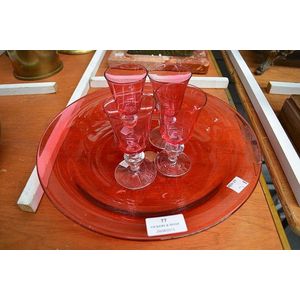Regency Rosewood Dining Chairs with Brass Inlays and Silk Upholstery
You must be a subscriber, and be logged in to view price and dealer details.
Subscribe Now to view actual auction price for this item
When you subscribe, you have the option of setting the currency in which to display prices to $Au, $US, $NZ or Stg.
- Stringing - Fine inlaid lines, in contrasting colour to the carcase timber, found mainly on furniture made in the styles of the later 18th and early 19th centuries. Stringing, which may be of satinwood, pine, ebony, horn, brass or occasionally ivory, is found principally on drawer fronts, around the outer edges of usually tapered legs and French bracket feet, around the edges of inlaid panels and between the joint of the cross banding and carcase timber on table tops, chests of drawers, cabinets etc. The effect is to emphasize the line of the piece and add to the impression of lightness and elegance. Stringing also occurs in Sheraton-revival-style furniture of the later 19th and early 20th centuries.
- Regency Period - The Regency period in English furniture design refers to the period when King George III, was declared unfit to rule in 1811, and his son ruled as proxy as Prince Regent, until 1820, and then, after the death of his father as George IV until his death in 1830. The Regency period was preceded by the Georgian period (George I, George II, and George III: 1714 - 1811), and was followed by the William IV period, which only lasted until 1837 when William IV died as was succeeded by Queen Victoria.
- Rosewood - A dense timber that varies in shade to very light brown to almost black. When rosewood is cut and sanded the colour of the timber will turn black, and after polishing and exposure to daylight, the surface will gradually lighten over time to light brown with black streaks.
The name comes from the odour emanating from the timber when it is planed, sanded or cut.
Rosewood was very popular for use in Victorian furniture in the second half of the 19th century, and at that time most of the rosewood was imported from Brazil. However it also grows in India and Indonesia.
It is used in the sold for chairs and table legs, but for carcase furniture such as side cabinets and bookcases, and for table tops it is always used as a veneer. - Drop in Seat - Mostly used on Regency upright chairs, a drop in (or "drop on") seat is an unsprung removable seat where the upholstery is attached to a wooden frame, which is held in place by the sides of the chair, and usually a wooden peg at the front of the chair. An inset upholstered seat is of the same construction, but it sits within a frame whose perimeter includes four sides of the chair.
Because the upholstery frame was not very deep, the seats were relatively uncomfortable. In the mid 19th century coiled upholstery springs came into use and frame of the chair was used as the upholstery frame, making for a much more comfortable and responsive seat.
This type of seat was known as an over-upholstered or over-stuffed seat. - Circa - A Latin term meaning 'about', often used in the antique trade to give an approximate date for the piece, usually considered to be five years on either side of the circa year. Thus, circa 1900 means the piece was made about 1900, probably between 1895 and 1905. The expression is sometimes abbreviated to c.1900.
- Sabre Leg - The sabre leg is commonly associated with chairs made in the Regency or classical revival manner of the early 19th century. The form was copied from designs of the ancient Grecian chair known as a klismos found on painted classical vases. The characteristic of the sabre leg is a wide, sweeping backward curve which was frequently reeded, similar to a sabre. The sweep of the front legs was sometimes complemented by a corresponding curve in the back legs of the chair, though on most domestic furniture the sweep of the rear support was not as pronounced. Sabre legs are often encountered in reproductions of the regency style. They are uncommon in Australian furniture where, by and large, colonial craftsmen preferred to use turned legs.
This item has been included into following indexes:
- chairs, sets of 4, style or period - all styles 491
- chairs, sets of 6, style or period
-
chairs, sets of 6, timber
- all styles and timbers 737
- rosewood 29
Visually similar items

A brooch by Georg Jensen, designed by Arno Malinowski, the Moonlight blossom brooch crafted in sterling silver, reference 283, 55 mm diameter.

A Mogul-style diamond pendant, faceted diamond macles set in a floral and filagree gold mount, metal tassels (later addition), testing as 22ct gold. Weight (all-in including metal tassels) 6.1g.

Large ruby glass bowl & four port glasses

9ct rose gold & diamond set ring, eight tiny diamonds set in pairs between cross pattern squares. Total weight 2.1gms, size: O/7-8
